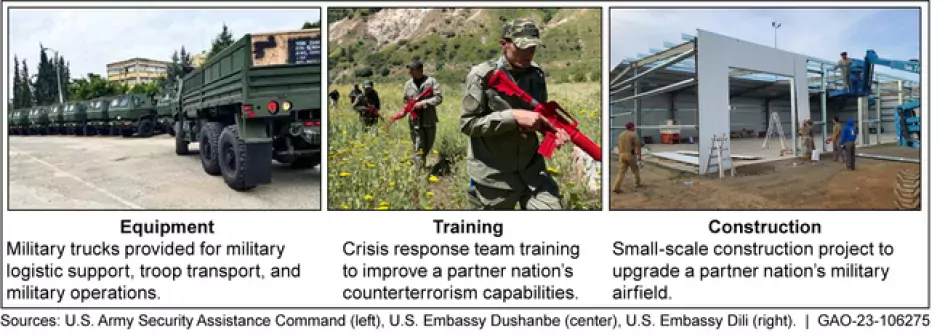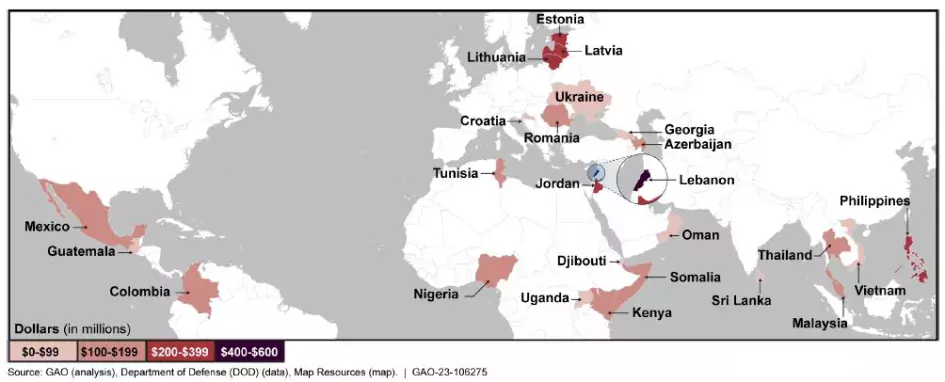Are We Really Helping? U.S. Security Assistance to Partner Nations Faces Challenges
The U.S. spends billions of dollars to train and equip foreign security forces in order to address global threats such as terrorism and narcotics trafficking. But is this assistance working?
Today’s WatchBlog post looks at our two recent reports about the effectiveness of one of the Department of Defense’s largest programs that provides assistance to partner nations’ security forces.
How does the U.S. provide assistance?
Through the Section 333 Building Partner Capacity program, DOD provides equipment, training, and other support to foreign security forces to build their capacity to address global threats. For example, a counter drug trafficking project provided monitoring and tracking equipment, such as sensors and radar, aircraft and related training. A cyberspace security project provided communications and electronic equipment—such as networking switches, servers, desktop computers, and training.
Examples of assistance
Image

In recent years, DOD funded nearly $5.6 billion for projects in at least 90 countries around the world. The majority of this funding (about 70%) went to the 25 countries shown in the map below. DOD officials told us they selected partner nations and projects based on the department’s strategic priorities—for example, preventing Chinese dominance of key regions and supporting deterrence against Russian aggression.
Top 25 Locations of Section 333 Projects, By Total Allocations, Fiscal Years 2018-2022
Image

In order for U.S. assistance to be successful, it needs to meet the needs of the country receiving it and be delivered in time for the country to use it.
DOD has met the mark with some of these projects. For example, its evaluations of projects found that a project providing Humvees to a country’s security forces strengthened that country’s ability to respond to crises and secure its border. DOD also found success with a project that improved a foreign air force training squadron’s ability to conduct counterdrug trafficking operations.
But we found that 75% of project activities were delayed, and more than half of the delays were at least a year long. And sometimes DOD provided the wrong solution to a country’s problem. For example, one project to provide ground sensors to border security troops failed after 3 months because the sensors had a short battery life and couldn’t withstand the country’s extreme temperatures.
Room for improvement
DOD’s own evaluations have found that persistent gaps in project planning have made some partner assistance activities less successful. We’ve also identified additional planning issues for the department to address. For example, while DOD is supposed to jointly plan projects with the Department of State to leverage its foreign policy expertise, we found that State has had a limited role in the program. DOD hasn’t created a process specifying when and how State should be involved. As a result, sometimes DOD has provided assistance that countries were reluctant to accept or could not use. We recommended ways for DOD and State to improve their collaboration on the program in our recent report.
DOD also hasn’t analyzed why so many of these projects were delayed to begin with. That’s why we recommended in our other recent report that DOD establish performance measures that include on-time delivery targets for assistance projects.
We also identified ways for DOD to improve how it evaluates if the provided assistance was effective—which would help the agency improve its planning for future projects.
Read our reports to learn more about our new work on DOD’s planning for its Section 333 Building Partner Capacity program and our other recent report on how DOD has implemented and evaluated these projects.
- Comments on GAO’s WatchBlog? Contact blog@gao.gov.
GAO Contacts
Related Products

GAO's mission is to provide Congress with fact-based, nonpartisan information that can help improve federal government performance and ensure accountability for the benefit of the American people. GAO launched its WatchBlog in January, 2014, as part of its continuing effort to reach its audiences—Congress and the American people—where they are currently looking for information.
The blog format allows GAO to provide a little more context about its work than it can offer on its other social media platforms. Posts will tie GAO work to current events and the news; show how GAO’s work is affecting agencies or legislation; highlight reports, testimonies, and issue areas where GAO does work; and provide information about GAO itself, among other things.
Please send any feedback on GAO's WatchBlog to blog@gao.gov.




